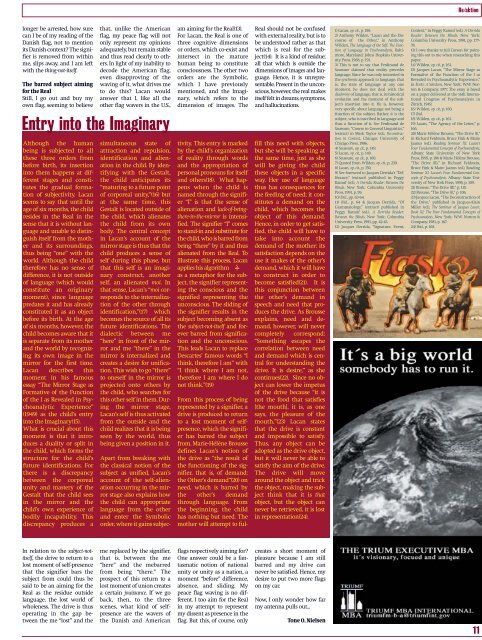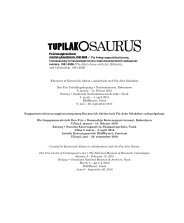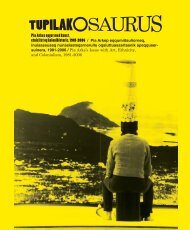See the paper Re/aktion as a PDF - Print matters!
See the paper Re/aktion as a PDF - Print matters!
See the paper Re/aktion as a PDF - Print matters!
Create successful ePaper yourself
Turn your PDF publications into a flip-book with our unique Google optimized e-Paper software.
longer be arrested, how sure<br />
can I be of my reading of <strong>the</strong><br />
Danish flag, not to mention<br />
its Danish context? The signifier<br />
is removed from within<br />
me, slips away, and I am left<br />
with <strong>the</strong> thing-not-itself.<br />
The barred subject aiming<br />
for <strong>the</strong> <strong>Re</strong>al<br />
Still, I go out and buy my<br />
own flag, seeming to believe<br />
that, unlike <strong>the</strong> American<br />
flag, my peace flag will not<br />
only represent my opinions<br />
adequately, but remain stable<br />
and thus read clearly to o<strong>the</strong>rs.<br />
In light of my inability to<br />
decode <strong>the</strong> American flag,<br />
even disapproving of <strong>the</strong><br />
waving of it, what drives me<br />
to do this? Lacan would<br />
answer that I, like all <strong>the</strong><br />
o<strong>the</strong>r flag wavers in <strong>the</strong> U.S.,<br />
Entry into <strong>the</strong> Imaginary<br />
Although <strong>the</strong> human<br />
being is subjected to all<br />
<strong>the</strong>se three orders from<br />
before birth, its insertion<br />
into <strong>the</strong>m happens at different<br />
stages and constitutes<br />
<strong>the</strong> gradual formation<br />
of subjectivity. Lacan<br />
seems to say that until <strong>the</strong><br />
age of six months, <strong>the</strong> child<br />
resides in <strong>the</strong> <strong>Re</strong>al in <strong>the</strong><br />
sense that it is without language<br />
and unable to distinguish<br />
itself from <strong>the</strong> mo<strong>the</strong>r<br />
and its surroundings,<br />
thus being “one” with <strong>the</strong><br />
world. Although <strong>the</strong> child<br />
<strong>the</strong>refore h<strong>as</strong> no sense of<br />
difference, it is not outside<br />
of language (which would<br />
constitute an originary<br />
moment), since language<br />
predates it and h<strong>as</strong> already<br />
constituted it <strong>as</strong> an object<br />
before its birth. At <strong>the</strong> age<br />
of six months, however, <strong>the</strong><br />
child becomes aware that it<br />
is separate from its mo<strong>the</strong>r<br />
and <strong>the</strong> world by recognizing<br />
its own image in <strong>the</strong><br />
mirror for <strong>the</strong> first time.<br />
Lacan describes this<br />
moment in his famous<br />
essay “The Mirror Stage <strong>as</strong><br />
Formative of <strong>the</strong> Function<br />
of <strong>the</strong> I <strong>as</strong> <strong>Re</strong>vealed in Psychoanalytic<br />
Experience”<br />
(1949) <strong>as</strong> <strong>the</strong> child’s entry<br />
into <strong>the</strong> Imaginary(15).<br />
What is crucial about this<br />
moment is that it introduces<br />
a duality or split in<br />
<strong>the</strong> child, which forms <strong>the</strong><br />
structure for <strong>the</strong> child’s<br />
future identifications. For<br />
<strong>the</strong>re is a discrepancy<br />
between <strong>the</strong> corporeal<br />
unity and m<strong>as</strong>tery of <strong>the</strong><br />
Gestalt that <strong>the</strong> child sees<br />
in <strong>the</strong> mirror and <strong>the</strong><br />
child’s own experience of<br />
bodily incapability. This<br />
discrepancy produces a<br />
In relation to <strong>the</strong> subject-notitself,<br />
<strong>the</strong> drive to return to a<br />
lost moment of self-presence<br />
that <strong>the</strong> signifier bars <strong>the</strong><br />
subject from could thus be<br />
said to be an aiming for <strong>the</strong><br />
<strong>Re</strong>al <strong>as</strong> <strong>the</strong> residue outside<br />
language, <strong>the</strong> lost world of<br />
wholeness. The drive is thus<br />
operating in <strong>the</strong> gap between<br />
<strong>the</strong> me “lost” and <strong>the</strong><br />
simultaneous state of<br />
attraction and repulsion,<br />
identification and alienation<br />
in <strong>the</strong> child. By identifying<br />
with <strong>the</strong> Gestalt,<br />
<strong>the</strong> child anticipates its<br />
“maturing to a future point<br />
of corporeal unity,”(16) but<br />
at <strong>the</strong> same time, this<br />
Gestalt is located outside of<br />
<strong>the</strong> child, which alienates<br />
<strong>the</strong> child from its own<br />
body. The central concept<br />
in Lacan’s account of <strong>the</strong><br />
mirror stage is thus that <strong>the</strong><br />
child produces a sense of<br />
self during this ph<strong>as</strong>e, but<br />
that this self is an imaginary<br />
construct, ano<strong>the</strong>r<br />
self, an alienated moi. In<br />
that sense, Lacan’s “moi corresponds<br />
to <strong>the</strong> internalization<br />
of <strong>the</strong> o<strong>the</strong>r through<br />
identification,”(17) which<br />
becomes <strong>the</strong> source of all its<br />
future identifications. The<br />
dialectic between me<br />
“here” in front of <strong>the</strong> mirror<br />
and me “<strong>the</strong>re” in <strong>the</strong><br />
mirror is internalized and<br />
creates a desire for unification.<br />
This wish to go “<strong>the</strong>re”<br />
to oneself in <strong>the</strong> mirror is<br />
projected onto o<strong>the</strong>rs by<br />
<strong>the</strong> child, who searches for<br />
this o<strong>the</strong>r self in <strong>the</strong>m. During<br />
<strong>the</strong> mirror stage,<br />
Lacan’s self is thus activated<br />
from <strong>the</strong> outside and <strong>the</strong><br />
child realizes that it is being<br />
seen by <strong>the</strong> world, thus<br />
being given a position in it.<br />
Apart from breaking with<br />
<strong>the</strong> cl<strong>as</strong>sical notion of <strong>the</strong><br />
subject <strong>as</strong> unified, Lacan’s<br />
account of <strong>the</strong> self-alienation<br />
occurring in <strong>the</strong> mirror<br />
stage also explains how<br />
<strong>the</strong> child can appropriate<br />
language from <strong>the</strong> o<strong>the</strong>r<br />
and enter <strong>the</strong> Symbolic<br />
order, where it gains subjec-<br />
me replaced by <strong>the</strong> signifier,<br />
that is, between <strong>the</strong> me<br />
“here” and <strong>the</strong> mebarred<br />
from being “<strong>the</strong>re.” The<br />
prospect of this return to a<br />
lost moment of union creates<br />
a certain jouissance. If we go<br />
back, <strong>the</strong>n, to <strong>the</strong> three<br />
scenes, what kind of selfpresence<br />
are <strong>the</strong> wavers of<br />
<strong>the</strong> Danish and American<br />
am aiming for <strong>the</strong> <strong>Re</strong>al(13).<br />
For Lacan, <strong>the</strong> <strong>Re</strong>al is one of<br />
three cognitive dimensions<br />
or orders, which co-exist and<br />
intersect in <strong>the</strong> mature<br />
human being to constitute<br />
consciousness. The o<strong>the</strong>r two<br />
orders are <strong>the</strong> Symbolic,<br />
which I have previously<br />
mentioned, and <strong>the</strong> Imaginary,<br />
which refers to <strong>the</strong><br />
dimension of images. The<br />
tivity. This entry is marked<br />
by <strong>the</strong> child’s organization<br />
of reality through words<br />
and <strong>the</strong> appropriation of<br />
personal pronouns for itself<br />
and o<strong>the</strong>rs(18). What happens<br />
when <strong>the</strong> child is<br />
named through <strong>the</strong> signifier<br />
“I” is that <strong>the</strong> sense of<br />
alienation and lack-of-being<strong>the</strong>re-in-<strong>the</strong>-mirror<br />
is intensified.<br />
The signifier “I” comes<br />
to stand-in and substitute for<br />
<strong>the</strong> child, who is barred from<br />
being “<strong>the</strong>re” by it and thus<br />
alienated from <strong>the</strong> <strong>Re</strong>al. To<br />
illustrate this process, Lacan<br />
applies his algorithm<br />
<strong>as</strong> a metaphor for <strong>the</strong> subject,<br />
<strong>the</strong> signifier representing<br />
<strong>the</strong> conscious and <strong>the</strong><br />
signified representing <strong>the</strong><br />
unconscious. The sliding of<br />
<strong>the</strong> signifier results in <strong>the</strong><br />
subject becoming absent <strong>as</strong><br />
<strong>the</strong> subject-not-itself and forever<br />
barred from signification<br />
and <strong>the</strong> unconscious.<br />
This leads Lacan to replace<br />
Descartes’ famous words “I<br />
think, <strong>the</strong>refore I am” with<br />
“I think where I am not,<br />
<strong>the</strong>refore I am where I do<br />
not think.”(19)<br />
From this process of being<br />
represented by a signifier, a<br />
drive is produced to return<br />
to a lost moment of selfpresence,<br />
which <strong>the</strong> signifier<br />
h<strong>as</strong> barred <strong>the</strong> subject<br />
from. Marie-Hélène Brousse<br />
defines Lacan’s notion of<br />
<strong>the</strong> drive <strong>as</strong> “<strong>the</strong> result of<br />
<strong>the</strong> functioning of <strong>the</strong> signifier,<br />
that is, of demand:<br />
<strong>the</strong> O<strong>the</strong>r’s demand”(20) on<br />
need, which is barred by<br />
<strong>the</strong> o<strong>the</strong>r’s demand<br />
through language. From<br />
<strong>the</strong> beginning, <strong>the</strong> child<br />
h<strong>as</strong> nothing but need. The<br />
mo<strong>the</strong>r will attempt to ful-<br />
flags respectively aiming for?<br />
One answer could be a fant<strong>as</strong>matic<br />
notion of national<br />
unity or unity <strong>as</strong> a nation, a<br />
moment “before” difference,<br />
absence, and sliding. My<br />
peace flag waving is no different.<br />
I too aim for <strong>the</strong> <strong>Re</strong>al<br />
in my attempt to represent<br />
my dissent <strong>as</strong> presence in <strong>the</strong><br />
flag. But this, of course, only<br />
S s<br />
<strong>Re</strong>al should not be confused<br />
with external reality, but is to<br />
be understood ra<strong>the</strong>r <strong>as</strong> that<br />
which is real for <strong>the</strong> subject(14).<br />
It is a kind of residue;<br />
all that which is outside <strong>the</strong><br />
dimensions of images and language.<br />
Hence, it is unrepresentable.<br />
Present in <strong>the</strong> unconscious,<br />
however, <strong>the</strong> real makes<br />
itself felt in dreams, symptoms,<br />
and hallucinations.<br />
fill this need with objects,<br />
but she will be speaking at<br />
<strong>the</strong> same time, just <strong>as</strong> she<br />
will be giving <strong>the</strong> child<br />
<strong>the</strong>se objects in a specific<br />
way. Her use of language<br />
thus h<strong>as</strong> consequences for<br />
<strong>the</strong> feeding of need; it constitutes<br />
a demand on <strong>the</strong><br />
child, which becomes <strong>the</strong><br />
object of this demand.<br />
Hence, in order to get satisfied,<br />
<strong>the</strong> child will have to<br />
take into account <strong>the</strong><br />
demand of <strong>the</strong> mo<strong>the</strong>r: its<br />
satisfaction depends on <strong>the</strong><br />
use it makes of <strong>the</strong> o<strong>the</strong>r’s<br />
demand, which it will have<br />
to construct in order to<br />
become satisfied(21). It is<br />
this conjunction between<br />
<strong>the</strong> o<strong>the</strong>r’s demand in<br />
speech and need that produces<br />
<strong>the</strong> drive. As Brousse<br />
explains, need and demand,<br />
however, will never<br />
completely correspond:<br />
“Something escapes <strong>the</strong><br />
correlation between need<br />
and demand which is central<br />
for understanding <strong>the</strong><br />
drive. It is desire,” <strong>as</strong> she<br />
continues(22). Since no object<br />
can lower <strong>the</strong> impetus<br />
of <strong>the</strong> drive because “it is<br />
not <strong>the</strong> food that satisfies<br />
[<strong>the</strong> mouth], it is, <strong>as</strong> one<br />
says, <strong>the</strong> ple<strong>as</strong>ure of <strong>the</strong><br />
mouth,”(23) Lacan states<br />
that <strong>the</strong> drive is constant<br />
and impossible to satisfy.<br />
Thus, any object can be<br />
adopted <strong>as</strong> <strong>the</strong> drive object,<br />
but it will never be able to<br />
satisfy <strong>the</strong> aim of <strong>the</strong> drive.<br />
The drive will move<br />
around <strong>the</strong> object and trick<br />
<strong>the</strong> object, making <strong>the</strong> subject<br />
think that it is that<br />
object, but <strong>the</strong> object can<br />
never be retrieved, it is lost<br />
in representation(24).<br />
creates a short moment of<br />
ple<strong>as</strong>ure because I am still<br />
barred and my drive can<br />
never be satisfied. Hence, my<br />
desire to put two more flags<br />
on my car.<br />
Now, I only wonder how far<br />
my antenna pulls out...<br />
Tone O. Nielsen<br />
1) Lacan, op. cit., p. 150.<br />
2) Anthony Wilden, “Lacan and <strong>the</strong> Discourse<br />
of <strong>the</strong> O<strong>the</strong>r,” in Anthony<br />
Wilden, The Language of <strong>the</strong> Self: The Function<br />
of Language in Psychoanalysis, Baltimore,<br />
Maryland: Johns Hopkins University<br />
Press, 1968, p. 191.<br />
3) This is not to say that Ferdinand de<br />
Saussure claimed that reality precedes<br />
language. Since he w<strong>as</strong> only interested in<br />
<strong>the</strong> synchronic approach to language, that<br />
is, <strong>the</strong> state of language at any one<br />
moment, he does not deal with <strong>the</strong><br />
diachrony of language, that is, its historical<br />
evolution and <strong>the</strong> moment of <strong>the</strong> subject’s<br />
insertion into it. He is, however,<br />
very specific about language not being a<br />
function of <strong>the</strong> subject. Ra<strong>the</strong>r, it is <strong>the</strong><br />
subject, who is inscribed in language and<br />
thus a function of it. <strong>See</strong> Ferdinand de<br />
Saussure, “Course in General Linguistics,”<br />
(extract) in Mark Taylor (ed.), Deconstruction<br />
in Context, Chicago: University of<br />
Chicago Press, 1986.<br />
4) Saussure, op. cit., p. 149.<br />
5) Lacan, op. cit., p. 149.<br />
6) Saussure, op. cit., p. 160.<br />
7) Quoted from Wilden, op. cit., p. 239.<br />
8) Lacan, op. cit., p. 150.<br />
9) <strong>See</strong> foreword to Jacques Derrida’s “Différance,”<br />
(extract) published in Peggy<br />
Kamuf (ed.), A Derrida <strong>Re</strong>ader: Between <strong>the</strong><br />
Blinds, New York: Columbia University<br />
Press, 1991, p. 59.<br />
10) Ibid., pp. 63-64.<br />
11) Ibid., p. 64 & Jacques Derrida, “Of<br />
Grammatology,” (extract) published in<br />
Peggy Kamuf (ed.), A Derrida <strong>Re</strong>ader:<br />
Between <strong>the</strong> Blinds, New York: Columbia<br />
University Press, 1991, pp. 42-43.<br />
12) Jacques Derrida, “Signature, Event,<br />
<strong>Re</strong>/<strong>aktion</strong><br />
Context,” in Peggy Kamuf (ed.), A Derrida<br />
<strong>Re</strong>ader: Between <strong>the</strong> Blinds, New York:<br />
Columbia University Press, 1991, pp. 177-<br />
78.<br />
13) I owe thanks to Juli Carson for pointing<br />
this out to me when researching this<br />
<strong>paper</strong>.<br />
14) Wilden, op. cit., p. 161.<br />
15) Jacques Lacan, “The Mirror Stage <strong>as</strong><br />
Formative of <strong>the</strong> Function of <strong>the</strong> I <strong>as</strong><br />
<strong>Re</strong>vealed in Psychoanalytic Experience,”<br />
in Écrits: A Selection, New York: W.W. Norton<br />
& Company, 1977. The essay is b<strong>as</strong>ed<br />
on a <strong>paper</strong> delivered at <strong>the</strong> 16th International<br />
Congress of Psychoanalysis in<br />
Zürich, 1949.<br />
16) Wilden, op. cit., p. 160.<br />
17) Ibid.<br />
18) Wilden, op. cit., p. 161.<br />
19) Lacan, “The Agency of <strong>the</strong> Letter,” p.<br />
166.<br />
20) Marie Hélène Brousse, “The Drive (I),”<br />
in Richard Feldstein, Bruce Fink & Maire<br />
Jaanus (ed.), <strong>Re</strong>ading Seminar XI: Lacan’s<br />
Four Fundamental Concepts of Psychoanalysis,<br />
Albany: State University of New York<br />
Press, 1995, p. 106 & Marie Hélène Brousse,<br />
“The Drive (II),” in Richard Feldstein,<br />
Bruce Fink & Maire Jaanus (ed.), <strong>Re</strong>ading<br />
Seminar XI: Lacan’s Four Fundamental Concepts<br />
of Psychoanalysis, Albany: State University<br />
of New York Press, 1995, p. 109.<br />
21) Brousse, “The Drive (II),” p. 115.<br />
22) Brousse, “The Drive (I),” p. 106.<br />
23) Jacques Lacan, “The Deconstruction of<br />
<strong>the</strong> Drive,” published in Jacques-Alain<br />
Miller (ed.), The Seminar of Jacques Lacan.<br />
Book XI: The Four Fundamental Concepts of<br />
Psychoanalysis, New York: W.W. Norton &<br />
Company, 1981, p. 167.<br />
24) Ibid., p. 168.<br />
11




